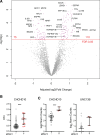Proteomic Analyses in COVID-19-Associated Secondary Hemophagocytic Lymphohistiocytosis
- PMID: 39888602
- PMCID: PMC11789895
- DOI: 10.1097/CCE.0000000000001203
Proteomic Analyses in COVID-19-Associated Secondary Hemophagocytic Lymphohistiocytosis
Abstract
Context: COVID-19 has been associated with features of a cytokine storm syndrome with some patients sharing features with the hyperinflammatory disorder, secondary hemophagocytic lymphohistiocytosis (sHLH).
Hypothesis: We hypothesized that proteins associated with sHLH from other causes will be associated with COVID-sHLH and that subjects with fatal COVID-sHLH would have defects in immune-related pathways.
Methods and models: We identified two cohorts of adult patients presenting with COVID-19 at two tertiary care hospitals in Seattle, Washington in 2020 and 2021. In this observational study, we assessed clinical laboratory values and plasma proteomics. Subjects identified as having sHLH (ferritin > 1000 plus cytopenias in two or more lineages [WBC < 5000 odds ratio [OR] ANC (absolute neutrophil count) < 1000, hemoglobin < 9 or hematocrit < 27, platelets < 100,000], and elevated transaminases [either AST (aspartate aminotransferase) or ALT (alanine aminotransferase) > 30] OR subjects with a ferritin > 3000) were compared with those with COVID-19 without sHLH. We identified 264 patients with COVID-19 of whom 24 met our sHLH definition. Eight patients who died of COVID-sHLH underwent genomic sequencing to identify variants in immune-related genes.
Results: Nine percent of enrolled COVID-19 subjects met our defined criteria for sHLH (n = 24/264). Using broad serum proteomic approaches (O-link and SomaScan), we identified three proteins increased in subjects with COVID-19-associated sHLH (soluble PD-L1 [sPD-L1], tumor necrosis factor-R1, and interleukin [IL]-18BP, p < 0.05 for O-link and false discovery rate < 0.05 for SomaScan), supporting a role for proteins previously associated with other forms of sHLH (IL-18BP and soluble tumor necrosis factor receptor 1). We also identified candidate proteins and pathways associated with COVID-sHLH, including sPD-L1 and the syntaxin pathway. We detected pathogenic variants in DOCK8 and TMPRSS15 in deceased individuals with COVID-sHLH, further suggesting that alterations in immune-related processes may contribute to hyperinflammation and fatal outcomes in COVID-19.
Interpretations and conclusions: Proteins increased in COVID-19-associated sHLH, such as sPD-L1, and pathways, such as the syntaxin pathway, suggest important roles for the immune response in driving sHLH in the context of COVID-19.
Copyright © 2025 The Authors. Published by Wolters Kluwer Health, Inc. on behalf of the Society of Critical Care Medicine.
Conflict of interest statement
Funding for this study was provided by the National Institutes of Health (NIH) grant R01AI150178-01S1 (to Dr. Hamerman), U19AI142733 (to Dr. Mikacenic), R01HL149676 (to Dr. Mikacenic), F32 HL156516 (to Dr. Canny), and NIH NHLBI T32 HL007287-42 (to Dr. Holton). Dr. Canny is also supported by the Arthritis National Research Foundation and a Childhood Arthritis and Rheumatology Research Alliance (CARRA)/Arthritis Foundation Career Development Award, Benaroya Family Foundation, the Leonard and Norma Klorfine Foundation, Glenn and Mary Lynn Mounger, Monolithic Power Systems, Biogen. The authors acknowledge CARRA and the ongoing Arthritis Foundation financial support of CARRA. Dr. Holton is also supported by a Parker B. Francis Foundation Fellowship. The remaining authors have disclosed that they do not have any potential conflicts of interest.
Figures



Update of
-
Identification of biomarkers for COVID-19 associated secondary hemophagocytic lymphohistiocytosis.bioRxiv [Preprint]. 2024 Aug 15:2024.08.13.607855. doi: 10.1101/2024.08.13.607855. bioRxiv. 2024. Update in: Crit Care Explor. 2025 Jan 31;7(2):e1203. doi: 10.1097/CCE.0000000000001203. PMID: 39185173 Free PMC article. Updated. Preprint.
References
Publication types
MeSH terms
Grants and funding
LinkOut - more resources
Full Text Sources
Medical
Research Materials
Miscellaneous

